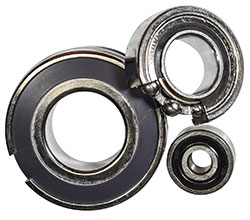How to Maintain a Bearing?
A bearing is a mechanical component designed to enable rotational or linear movement while reducing friction and supporting loads. Bearings are commonly used in various machinery, ranging from automotive systems to industrial equipment, and they play a crucial role in facilitating smooth and efficient motion. This article by ATO Store serves as a comprehensive guide to help you navigate the maintenance of bearings effectively.
Disassembly of Bearings
The disassembly of bearings is part of regular maintenance and is conducted when bearings need replacement. After disassembly, if continued use is required or the condition of the bearings needs to be inspected, the disassembly process should be as careful as during installation. Special attention should be paid to avoid damaging various components of the bearing, especially in the disassembly of interference-fit bearings, which can be challenging. Designing and creating disassembly tools according to requirements are also crucial. During disassembly, the disassembly method, sequence, and the conditions of the bearing should be studied based on the drawings to ensure a flawless disassembly operation.

For the disassembly of the interference-fit outer ring, screws are pre-set on the circumference of the housing and evenly tightened before disassembly. In the case of separable bearings such as tapered roller bearings, notches are made on the shoulder of the housing, and a press or gentle tapping is used for disassembly. The disassembly of the inner ring can be done easily with a press. Care must be taken to ensure that the inner ring bears the pulling force. Various pullers, as shown, are commonly used. Regardless of the type of puller, it must be securely fixed on the side of the inner ring. For this, the dimensions of the shaft shoulder need to be considered, or grooves can be machined at the shoulder for the use of pullers.
The disassembly of the inner ring of large bearings utilizes hydraulic pressure. By applying hydraulic pressure to the oil hole in the bearing, it becomes easier to pull out. For wide bearings, a combination of hydraulic pressure and pullers is used for the disassembly operation. The disassembly of the inner ring of cylindrical roller bearings can utilize the induction heating method. The method involves locally heating the inner ring for a short duration, causing it to expand for easy removal. The induction heating method is also used when a large number of inner rings of such bearings need to be installed.
Cleaning of Bearings
- When removing bearings for inspection, start by taking visual records using methods such as photography. Additionally, confirm the quantity of remaining lubricant, sample the lubricant, and then proceed with the cleaning of the bearings.
The cleaning of bearings is done in two stages. coarse cleaning and fine cleaning. A metal mesh is placed at the bottom of the container used for cleaning. - During coarse cleaning, use a brush to remove grease or adhering substances from the bearings immersed in oil. When rotating the bearings in oil at this stage, be cautious as foreign particles may damage the rolling surfaces.
- During fine cleaning, slowly rotate the bearings in oil and conduct a meticulous cleaning.
Commonly used cleaning agents are neutral, water-free diesel or kerosene, and, if necessary, sometimes a warm alkaline solution is used. Regardless of the cleaning agent, regular filtering is necessary to maintain cleanliness. After cleaning, immediately apply rust preventive oil or grease to the bearings.
Notes for Bearings
From a usage perspective, ensuring the reliable operation of bearings requires attention to the following points:
- Improve Lubrication Quality:
Enhance the quality of lubrication by controlling the pressure, temperature, and flow of engine oil, and strengthen oil filtration. - Use Prescribed Fuels and Lubricants:
Utilize fuels and lubricants that meet the specified requirements. - Control Diesel Generator Set Temperature:
Operating under excessively cold or hot conditions is unfavorable. In cold weather, preheat the diesel engine before starting, and manually rotate the crankshaft to ensure that oil enters the friction surfaces. - Ensure Surface Quality and Geometry of Bearings and Shafts:
Strictly maintain the surface quality and geometric shape of bearings and shafts. - Maintain Appropriate Bearing Clearance:
Ensure that bearing clearance is appropriate; excessive clearance may generate impact, while insufficient clearance may result in poor lubrication and potential bearing damage. - Maintain Appropriate Bearing Clearance:
Ensure that bearing clearance is appropriate; excessive clearance may generate impact, while insufficient clearance may result in poor lubrication and potential bearing damage. - Ensure Surface Quality and Geometry of Bearings and Shafts:
Strictly maintain the surface quality and geometric shape of bearings and shafts. - Improve Lubrication Quality:
Enhance the quality of lubrication by controlling the pressure, temperature, and flow of engine oil, and strengthen oil filtration. - Use Prescribed Fuels and Lubricants:
Utilize fuels and lubricants that meet the specified requirements.
To ensure that bearings fully exhibit their intended performance and maintain it over the long term, effective periodic maintenance (regular inspections) must be carried out. Through appropriate periodic inspections, early detection of faults can be achieved, preventing accidents before they occur, which is crucial for improving productivity and economic efficiency.

